It takes dedication and a proactive mindset to measure and improve course performance, which is a continuous process.
Knowing how well your courses perform is crucial to upholding high standards and promoting user success in the cutthroat world of online education. Constant improvement should be at the core of your approach, regardless of experience level with creating courses. This is a thorough tutorial on how to assess and enhance your performance in the course.
Define Clear Objectives
Establish Learning Goals
Establish first what constitutes success in your course. Set measurable, unambiguous learning objectives that correspond with your overarching academic objectives. This will give you a starting point for determining whether your course is producing the desired results.
Set Performance Benchmarks
Establish benchmarks for several areas of your course, like user happiness, engagement, and completion rates. The performance will be assessed using these benchmarks as a point of comparison.
Utilize Analytics Tools
Learning Management System (LMS) Analytics
An analytics tool is typically integrated into an LMS platform. Track important indicators including user progress, course completion rates, and enrollment figures with these tools. Examine this data to find patterns and opportunities for development.
Engagement Metrics
Track indicators related to user engagement, such as the amount of time spent on course materials, involvement in discussions, and use of multimedia. Improved learning outcomes are frequently correlated with high levels of engagement.
Gather User Feedback
Surveys and Questionnaires
Give your users surveys and questionnaires on a regular basis to get their opinions on the material, the way it was taught, and the entire experience. Make data-driven judgments regarding course enhancements using the input provided here.
Focus Groups
To obtain more in-depth information about users' educational experiences, hold focus groups with a small sample of them. These conversations may unearth important qualitative information that surveys by themselves could miss.
Analyze Assessment Results
Performance on Quizzes and Exams
Examine and analyze user performance to find common areas of difficulty. This could bring to light subjects that require more in-depth discussion or alternative teaching strategies.
Assignment and Project Feedback
Examine the caliber of the projects and assignments that the users have turned in. Examine the instructor's feedback for trends that indicate the areas in which users are performing well and those in which they are not.
Implement Continuous Improvement Strategies
Iterative Course Design
Use an iterative process for creating your courses. Make frequent updates and revisions to your course content in light of user feedback and data. This guarantees the continued relevance and efficacy of your course.
Professional Development
Make an investment in your own and your instructors' professional growth. Attend conferences, seminars, and workshops to remain current on the newest approaches to teaching and learning technology.
Incorporate New Technologies
Investigate and incorporate fresh methods and technology that can improve education. Virtual reality simulations, interactive multimedia, and adaptive learning systems are a few examples of this.
Promote a Culture of Feedback
Encourage User Input
Establish a setting where users are at ease offering candid criticism. Let them know that you appreciate their feedback and will utilize it to make the course better.
Regular Instructor Reviews
To make sure course creators are successfully involving users and promoting learning, conduct frequent evaluations and training sessions. Give them helpful criticism and encouragement so they can enhance their teaching strategies.
It takes commitment and initiative to measure and improve course performance; it is a continuous effort. You can make sure that your courses provide excellent learning experiences that satisfy the needs of your users by establishing clear objectives, utilizing analytics, obtaining feedback from users, examining assessment data, and putting continuous improvement techniques into practice. Adopt these strategies to maintain a competitive edge in the rapidly changing field of online learning and cultivate a culture of excellence within your learning community.





